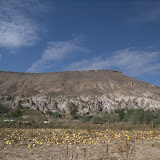If there has been one constant in our cycle through the changing landscapes of Turkey it must surely be tea, or çay (ç is pronounced 'ch'). Throughout the villages and towns of Turkey are scattered tea salons and gardens (çay bahçesi) where people gather to sip this strong beverage and natter about daily life. Old men play cards, chain-smoking is the order of the day and çay may be the only item on the menu. In towns, tea-waiters (çaycı) ferry trays of small tea-glasses around the neighbourhood of their shop when they are called. For us, these tea houses were a welcome refuge, where we could sit under grape vines or watch the passing street life and give the Surlys a tea break of their own.
 |
| From Turkish tea |
The national drink has international origins, deriving its name from the Chinese – we have also met it as ‘tsai’ in Mongolia and ‘chai’ in Central Asia - and borrowing its brewing style from that of the Russian samovar. The double kettle allows a strong brew to be made on top, later diluted to taste with the remaining water from below. A surprisingly recent phenomenon in Turkey, tea was encouraged as a healthy alternative to coffee in the late 19th century and then a cheaper alternative when the Ottoman Empire collapsed, losing its coffee holdings in Yemen. With imported seeds from Georgia tea plantations were founded around Rize on the Black Sea coast which today supports the habit of one of the highest per capita consumers in the world.
 |
| From Turkish tea |
We moved on from Cappadocia and punctureville, holding our breath and our PSI, and headed out through villages wrapped around Byzantine caves and perched on top of ancient subterranean cities. In these parts the main crops seemed to be grapes and pumpkins left long on the vines until they are shelled for their seeds, a sought-after snack here. In the agricultural lands beyond, we entered a land of low-slung baggy pants and numerous old men wandering between cay salons in the villages like slow-moving targets in a police-training exercise. A couple of women trudging on a long stretch between villages yelled out to us in passing – my interpretation involved a commentary on the upcoming hill-climb – and I realized that this was one of our few verbal interactions with women who were largely silent as we passed by. To this point I had only seen two females in tea salons thus far: one under 9 and one over 90. Had I been violating secret men’s business by brazenly sipping my cay, hair and lower legs uncovered?
 |
| From Turkish tea |
Our next few nights allowed me a chance to ponder this, along with a consideration of the relative merits of different types of land-use as it pertains to the camping cycle-tourist. Wheat farming land is flat, which is a bonus, but it is stubbly and lacking in geographical formations for visual protection from the road. Apple farms are much nicer. Groves of fruit-laden trees in a heavily irrigated grassy river valley amidst craggy mountains formed much of our scenery for a couple of days, and a pleasant spot for a night’s rest. The farmers seemed unperturbed by our brightly coloured presence, and we attributed this to the fact that they were probably workers rather than owners of these large commercial enterprises. It may just be a Turkish sense of hospitality at play again. The third night saw us enter steep pine-laden mountains with a bevy of thunderstorms on the way. Not to be put off, we stopped early and excavated ourselves a flat sleeping area in the soft soil, employing pine-needles to prevent seepage into the tent.
Somewhere back between the wheat and apple farms we ran into a classic example of roadside hospitality. Tuna (really), the local proprietor of the grain warehouse, waved us over for some cay and conversation as we searched for a tap to replenish our water supplies. As we sipped tea and he sipped Coke, we performed the standard information exchange – name, country of origin, age, destination, marital status, children – and Tuna added in his vote for motorbikes being the superior way to travel. Well, differences can be smoothed over with çay, I say.
Our final hill climbs over misty, cold mountains led us on to a great set of winding fast descents until we passed through a gap in the rocks and all of a sudden things became Mediterranean. Olive groves, citrus farms, goat herders and eucalypts that smelt a lot like home. We hit the sprawling metropolis of the coast, and I found cafes and tea salons teeming with men, women and children of all ages. Here was cosmopolitan, chain-store Turkey. It seemed a world away from the villages, but around corners and down alleyways the old men still sat, smoked and dealt. Though the foreigner’s exception had probably applied to me in many places, here, though I could not quite blend in, I could comfortably mix it up with the city crowd in the çay salons.
 |
| From Turkish tea |
So, I have become a fan of Turkish tea. It is a drink of friendship, of social interaction – though not always all-inclusive. And perhaps, with its 15 minute brew-time, a caffeine content that could rival my other Turkish delight, coffee.
Lake Stealth Camp to Wheat Field Camp - 82km
Wheat Field Camp to Apple Grove Camp - 62km
Apple Grove Camp to Pine Tree Hill Camp - 62km
Pine Tree Hill Camp to Tarsus - 77km
Tarsus to Mersin - 31km
Lake Stealth Camp to Wheat Field Camp - 82km
Wheat Field Camp to Apple Grove Camp - 62km
Apple Grove Camp to Pine Tree Hill Camp - 62km
Pine Tree Hill Camp to Tarsus - 77km
Tarsus to Mersin - 31km
Mersin to Taşucu - 102km
Total - 416km
Total - 416km
 |
| Cappadocia to the Coast |





0 comments:
Post a Comment